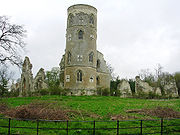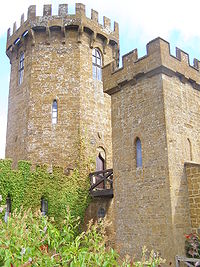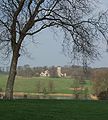
Sanderson Miller
Encyclopedia

Architecture
Architecture is both the process and product of planning, designing and construction. Architectural works, in the material form of buildings, are often perceived as cultural and political symbols and as works of art...
, and a landscape designer who often added follies
Folly
In architecture, a folly is a building constructed primarily for decoration, but either suggesting by its appearance some other purpose, or merely so extravagant that it transcends the normal range of garden ornaments or other class of building to which it belongs...
or other Picturesque
Picturesque
Picturesque is an aesthetic ideal introduced into English cultural debate in 1782 by William Gilpin in Observations on the River Wye, and Several Parts of South Wales, etc. Relative Chiefly to Picturesque Beauty; made in the Summer of the Year 1770, a practical book which instructed England's...
garden buildings and features to the grounds of an estate.
Early life
At the age of fifteen, Miller was already interested in antiquarianAntiquarian
An antiquarian or antiquary is an aficionado or student of antiquities or things of the past. More specifically, the term is used for those who study history with particular attention to ancient objects of art or science, archaeological and historic sites, or historic archives and manuscripts...
subjects, and while studying at St Mary Hall, Oxford
St Mary Hall, Oxford
St Mary Hall was an academic hall of the University of Oxford associated with Oriel College since 1326, but which functioned independently from 1545 to 1902.- History :...
he continued to develop his interest in England
England
England is a country that is part of the United Kingdom. It shares land borders with Scotland to the north and Wales to the west; the Irish Sea is to the north west, the Celtic Sea to the south west, with the North Sea to the east and the English Channel to the south separating it from continental...
's past. He inherited Radway Grange when he was only twenty-one and a few years later started to redesign the Elizabethan
Tudor style architecture
The Tudor architectural style is the final development of medieval architecture during the Tudor period and even beyond, for conservative college patrons...
house in a Gothic
Gothic architecture
Gothic architecture is a style of architecture that flourished during the high and late medieval period. It evolved from Romanesque architecture and was succeeded by Renaissance architecture....
style.

Guy of Warwick
Guy of Warwick is a legendary English hero of Romance popular in England and France from the 13th to the 17th century. The story of Sir Guy is considered by scholars to be part of the Matter of England.-Plot:...
Tower at Warwick Castle
Warwick Castle
Warwick Castle is a medieval castle in Warwick, the county town of Warwickshire, England. It sits on a bend on the River Avon. The castle was built by William the Conqueror in 1068 within or adjacent to the Anglo-Saxon burh of Warwick. It was used as a fortification until the early 17th century,...
. The tower not only evoked the past visually through its medieval design but it also had strong historical associations of other kinds: for instance, it was intended to house a statue of Caractacus and was sited on the spot traditionally associated with the king
Charles I of England
Charles I was King of England, King of Scotland, and King of Ireland from 27 March 1625 until his execution in 1649. Charles engaged in a struggle for power with the Parliament of England, attempting to obtain royal revenue whilst Parliament sought to curb his Royal prerogative which Charles...
raising the standard before the Battle of Edgehill
Battle of Edgehill
The Battle of Edgehill was the first pitched battle of the First English Civil War. It was fought near Edge Hill and Kineton in southern Warwickshire on Sunday, 23 October 1642....
.

Patronage & Developments
This work at Radway established Miller's reputation as a gentleman, or amateurAmateur
An amateur is generally considered a person attached to a particular pursuit, study, or science, without pay and often without formal training....
, architect and landscape designer. His wide social circle, and contacts developed through his patron George Lyttelton, 1st Baron Lyttelton
George Lyttelton, 1st Baron Lyttelton
George Lyttelton, 1st Baron Lyttelton PC , known as Sir George Lyttelton, Bt between 1751 and 1756, was a British politician and statesman and a patron of the arts.-Background and education:...
, led to many requests for his designs. He produced some classical buildings like the Shire Hall in Warwick
Warwick
Warwick is the county town of Warwickshire, England. The town lies upon the River Avon, south of Coventry and just west of Leamington Spa and Whitnash with which it is conjoined. As of the 2001 United Kingdom census, it had a population of 23,350...
and Hagley Hall
Hagley Hall
Hagley Hall is an 18th century house in Hagley, Worcestershire. It was the creation of George Lyttelton, 1st Baron Lyttelton , secretary to Frederick, Prince of Wales, poet and man of letters and briefly Chancellor of the Exchequer...
, Worcestershire
Worcestershire
Worcestershire is a non-metropolitan county, established in antiquity, located in the West Midlands region of England. For Eurostat purposes it is a NUTS 3 region and is one of three counties that comprise the "Herefordshire, Worcestershire and Warwickshire" NUTS 2 region...
, but is more often associated with Gothic revival work, as at Albury Hall, Oxfordshire
Oxfordshire
Oxfordshire is a county in the South East region of England, bordering on Warwickshire and Northamptonshire , Buckinghamshire , Berkshire , Wiltshire and Gloucestershire ....
and the Great Hall at Lacock Abbey
Lacock Abbey
Lacock Abbey in the village of Lacock, Wiltshire, England, was founded in the early 13th century by Ela, Countess of Salisbury, as a nunnery of the Augustinian order.- History :...
. He is especially known for the evocative mock "ruined" castles he created at Hagley, Wimpole Hall
Wimpole Hall
Wimpole Hall is a country house located within the Parish of Wimpole, Cambridgeshire, England, about 8½ miles southwest of Cambridge. The house, begun in 1640, and its 3,000 acres of parkland and farmland are owned by the National Trust and are regularly open to the public.Wimpole is...
and Ingestre Hall
Ingestre Hall
Ingestre Hall is a 17th century Jacobean mansion situated at Ingestre, near Stafford, Staffordshire, England, which is now in use as a Residential Arts and Conference Centre. It is a Grade II* listed building.Ingestre is mentioned in the Domesday Book...
, Staffordshire
Staffordshire
Staffordshire is a landlocked county in the West Midlands region of England. For Eurostat purposes, the county is a NUTS 3 region and is one of four counties or unitary districts that comprise the "Shropshire and Staffordshire" NUTS 2 region. Part of the National Forest lies within its borders...
though this last has since been demolished. Other places to which he contributed include Wroxton Abbey
Wroxton Abbey
Wroxton Abbey is a Jacobean house in Oxfordshire, with a 1727 garden partly converted to the serpentine style between 1731 and 1751. It is west of Banbury, off the A422, in Wroxton St. Mary. It is now the English campus of Fairleigh Dickinson University....
, Upton House Sham Castle
Sham Castle
Sham Castle is a folly in Bathampton overlooking the city of Bath, Somerset, England. It is a Grade II* listed building. It is a screen wall with a central pointed arch flanked by two 3-storey circular turrets, which extend sideways to a 2-storey square tower at each end of the wall.It was probably...
and Siston Court
Siston
Siston is a small village in South Gloucestershire, England east of Bristol Castle, ancient centre of Bristol, recorded historically as Syston, Sistone, Syton, Sytone and Systun etc. The village lies at the confluence of the two sources of the Siston Brook, a tributary of the River Avon...
.
He married Susannah (née Trotman) and they had six children. Miller was born, lived and died at Radway, on the estate bought by his wool merchant father.

Sources
- William Hawkes, The Diaries of Sanderson Miller (Dugdale 2005)
- Oxford Dictionary of National Biography
Further reading
- Jennifer Meir, Sanderson Miller and his Landscapes (Phillimore 2006)
- Michael Cousins, "Wroxton Abbey, Oxfordshire: an eighteenth-century estate", Follies Journal, no 5 (2005), pp. 39-72.
- Michael Cousins, "The sham ruin, Hagley", Follies Magazine, vol. 10, no. 1 (1998), pp. 3-4.
- Michael Cousins, "Lady Elizabeth's Grotto [Hagley]", Follies Magazine, #64, pp. 14-16.

